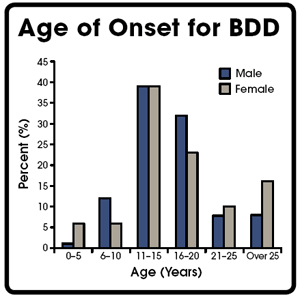Fixing the Broken Mirror: Body Dysmorphic Disorder
Katharine Phillips, MD
Director, Body Dysmorphic Disorder Program, Butler Hospital, Professor of Psychiatry, Brown Medical School
Body Dysmorphic Disorder (BDD) was virtually unknown when Dr. Katharine Phillips, still in her residency, first encountered a number of patients with unusual, and unusually debilitating, symptoms. As she tells it, “some of these perfectly normal looking people were so incredibly distressed by their appearance that they were housebound and even considering suicide.” In the subsequent 15–20 years, no one has done as much as Dr. Phillips, currently director of the BDD Program at Butler Hospital in Providence, RI, and Professor of Psychiatry at Brown Medical School, to bring BDD into the public and clinical eye.
“I began with the basics,” she says. “What are the symptoms? What sorts of experiences do patients with BDD have? What are common comorbidities? How do we treat these patients?” Her recent updated and revised book, The Broken Mirror: Understanding and Treating Body Dysmorphic Disorder , serves as an excellent guide for the clinician, as well as valuable reading for any person suffering from, or dealing with someone who is suffering from, BDD.
More recently, Dr. Scott Rauch and Dr. Phillips did a preliminary neuroimaging study on patients with BDD. The results showed increased total white matter and a relative leftward shift in caudate asymmetry (this has offered some support for theories that BDD may be related to OCD, although patients with OCD tend to have a relative rightward shift in caudate asymmetry).
“More imaging studies are needed,” Dr. Phillips acknowledges, “but what we’ve done so far shows that something particular and unique is going on in the brains of patients with BDD.”
Epidemiology
The epidemiology is understudied, but rates of BDD in the general population is around 1%. One telling study of psychiatric inpatients found a BDD prevalence of 13%. All the patients meeting the criteria for BDD in this study identified this disorder as a major problem (Table). Dr. Phillips estimates the prevalence in the general population at around 1–2%. Further, studies have suggested that 9–12% of patients seeking dermatological treatment and 6–15% of patients seeking cosmetic surgery have BDD.
Diagnosis
BDD is “vastly underrecognized and vastly underdiagnosed,” stresses Dr. Phillips. The DSM-IV defines BDD as a preoccupation (not better accounted for by another mental disorder) with an imagined or slight defect in appearance causing clinically significant distress or impairment in functioning (often social and occupational). Screening is very important for BDD, as it very frequently co-presents with depression, anxiety, and/or social phobia, and sufferers may not volunteer their preoccupation with their appearance due to embarrassment. When screening, the basic thing to look for is any evidence of over-concern with appearance. Depression can also be a non-specific clue (especially if it doesn’t resolve with standard treatment), as can social anxiety and referential thinking—people with BDD may be misdiagnosed with paranoia or schizophrenia. BDD also often coexists with substance abuse.
Treatment
“The first thing,” Dr. Phillips explains, “is to help patients understand that they actually have an illness. It may also be helpful to note that others don’t see the patient in the same way the patient sees him or herself.” She further points out that patients with BDD generally have very poor insight, and may reject the diagnosis. It’s important to try and convince them that cosmetic surgery is unlikely to resolve their issues. Following that, there are two compatible avenues of treatment.
SRIs have shown promise, and studies have shown that their effect isn’t solely due to alleviation of depression. However, they often need to be prescribed at higher doses than they do for depression, Dr. Phillips notes. “If they don’t respond at a lower dose, don’t be afraid to go higher.”
Cognitive behavioral therapy has also shown some success. The therapist needs to use both cognitive approaches—focusing on helping BDD patients to recognize errors in their way of thinking (eg, “what evidence do you really have that you know what other people think about you?”)—and behavioral approaches, for instance, having the patients cut down on mirror checking.
Conclusion
“The bottom line,” Dr. Phillips says, “is that this is a serious illness. Functioning and quality of life for these patients is on average abysmal, and BDD patients have very high rates of suicidality.” BDD is often missed in clinical studies, and is very underdiagnosed. It’s important to remember that it often masquerades as other disorders. Screening for it is easy—clinicians just need to be aware.

